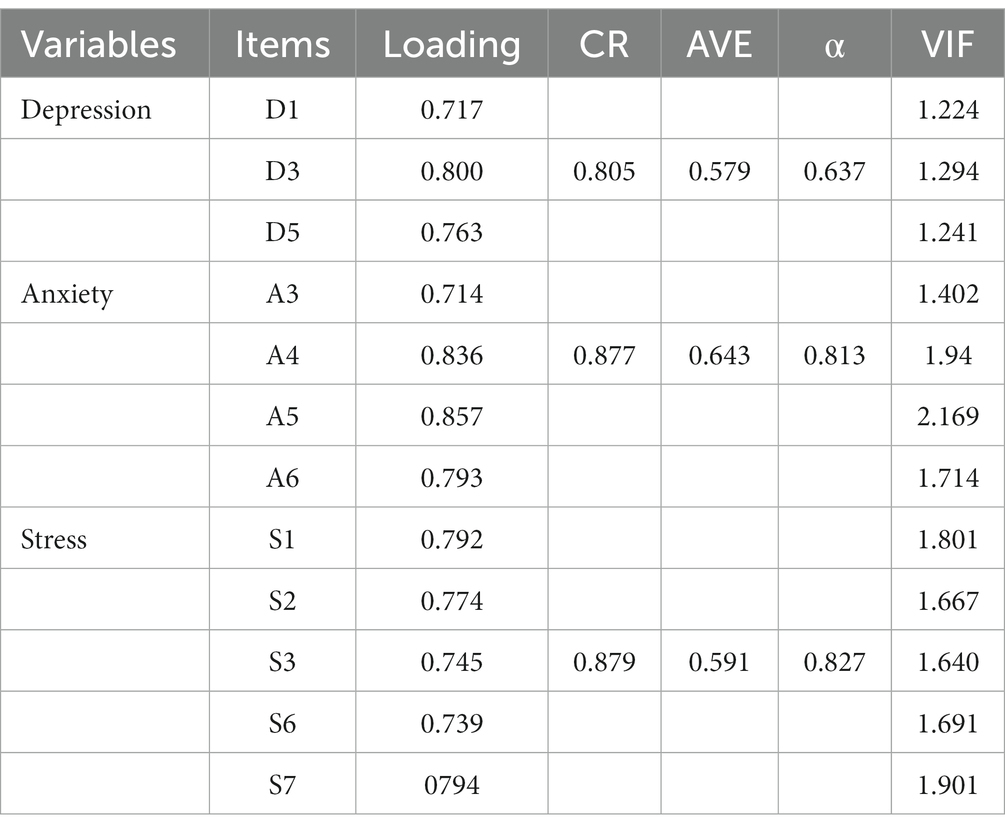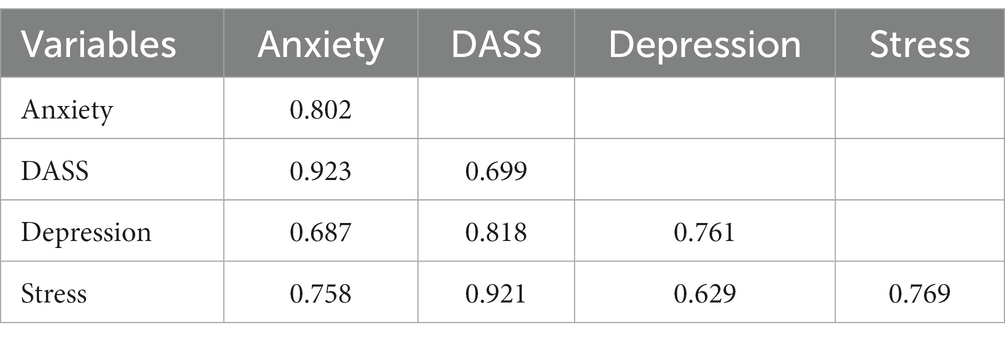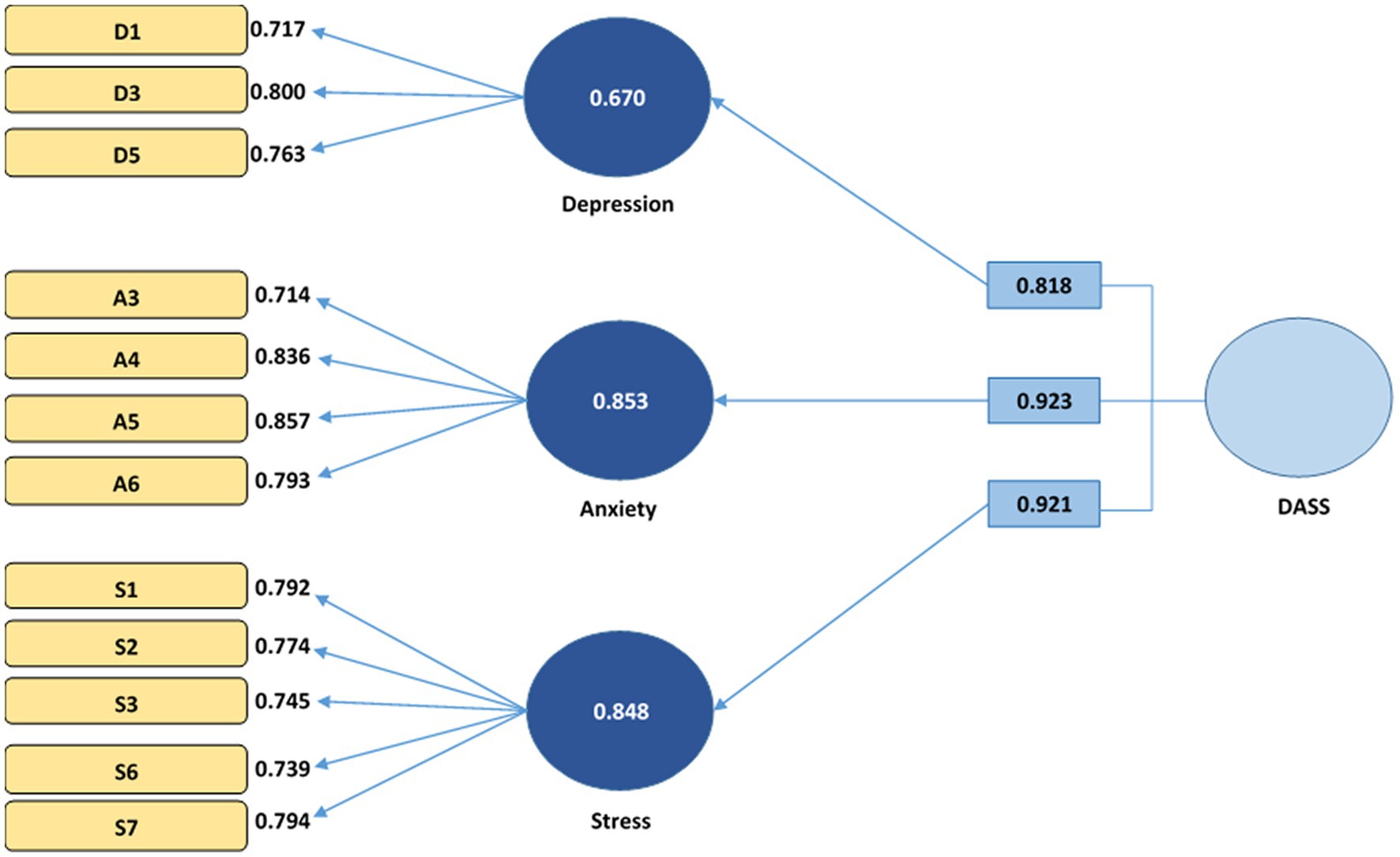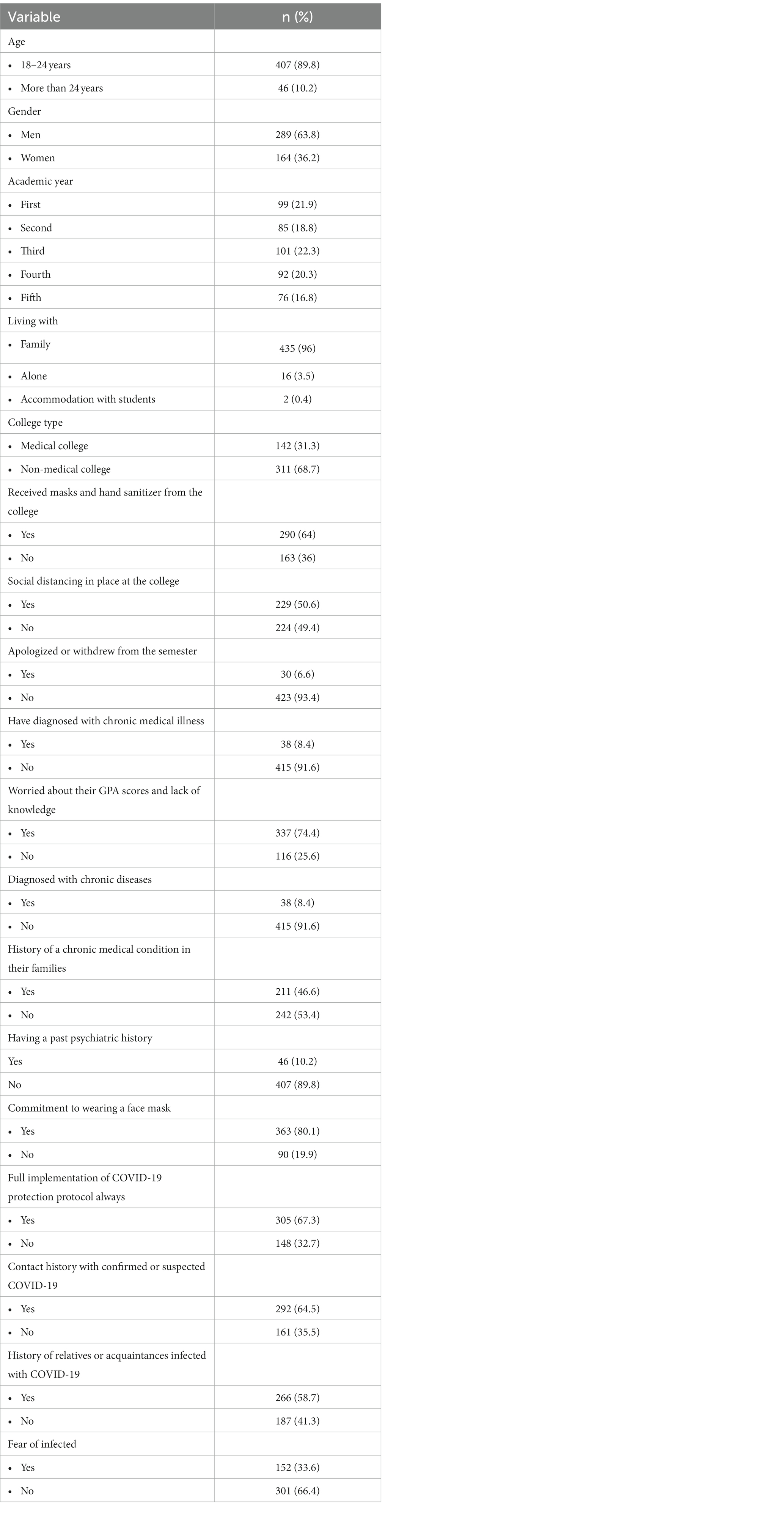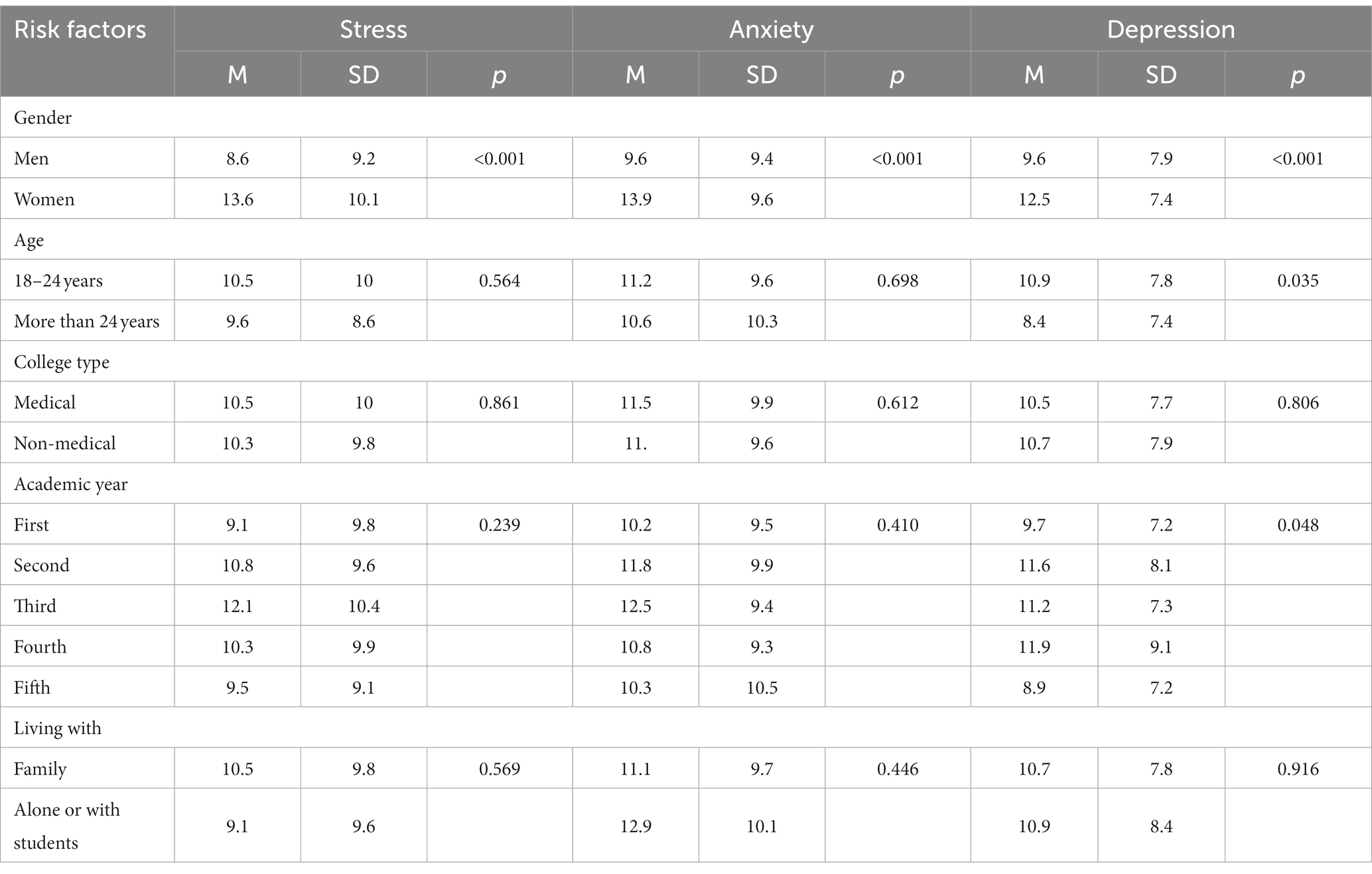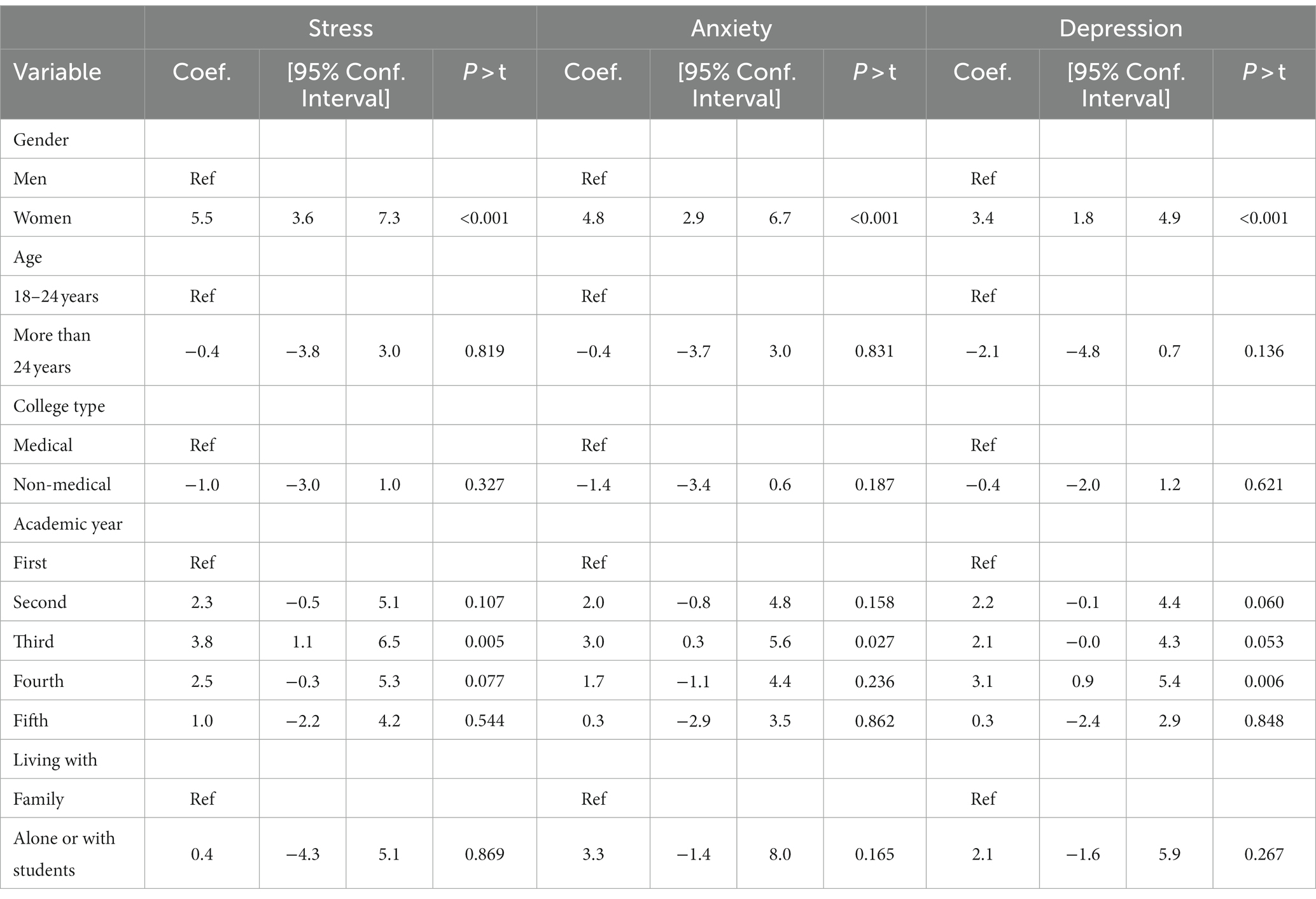- 1Department of Public Health, College of Public Health and Health Informatics, Qassim University, Al Bukairiyah, Saudi Arabia
- 2School of Health, University of New England, Armidale, NSW, Australia
Background: The public health measures taken in educational institutions during the COVID-19 pandemic had complex influences on students’ mental health. This study aimed to evaluate the prevalence and sociodemographic determinants of Depression, Anxiety, and Stress immediately after the COVID-19 pandemic among students at Qassim University, Saudi Arabia.
Methods: We conducted a cross-sectional study among Qassim University students in Saudi Arabia. All students registered for the academic year 2022 were invited to participate in a survey through social media. A total of 453 participants completed an online survey that included the DASS-21 for assessing the emotional states of Depression, Anxiety, and Stress.
Results: The mean scores for Depression, Anxiety, and Stress, were 10.70, 11.18, and 10.40, respectively. At least 18% of the students reported experiencing moderate-to-severe levels of Depression, Anxiety, and Stress. The study showed that the feminine gender was associated with higher Depression, Anxiety, and Stress scores.
Conclusion: Students in the current study described experiencing higher levels of Depression, Anxiety, and Stress during the COVID-19 pandemic. The findings of the present study can help universities take targeted measures to address the impact of a pandemic like COVID-19 on students’ mental health.
1 Introduction
The outbreak of coronavirus disease (COVID-19) has had a significant impact on the lives of people around the world, particularly after the declaration of a global pandemic by the World Health Organization on 11 March 2020 (1). In response to the pandemic, many countries have implemented a range of public health and social measures, such as travel and personal movement restrictions, shutting down of public areas, mandating face masks, and other measures to combat COVID-19. Saudi Arabia reacted quickly by imposing strict public health measures, including a travel ban, shutting down shopping centers and mosques, applying lockdown measures, implementing curfews, and suspending physical attendance to all educational institutions and workplaces except for critical jobs (2–4). The alarming increase in COVID-19 cases worldwide during the pandemic was associated with a considerable change in many aspects of people’s lives. This unprecedented situation impacted people’s psychological status. People were frightened and anxious. A recent systematic review reported that, during the pandemic, the prevalence of Stress was 29.6%, Anxiety was 31.9%, and Depression was 33.7% among the general population (5). Even before the COVID-19 pandemic, the world experienced various outbreaks over the past few decades, which caused post-traumatic Stress symptoms among people living in outbreak areas (6). Studies have also shown that the swine flu, Ebola, MERS, and SARS epidemics have caused mental health problems such as Depression, Anxiety, and fear of infection (7–9).
Universities and schools in Saudi Arabia have smoothly moved to virtual and distance learning during the pandemic. This shift was supported by the enhanced technology and digitalization of most services in the country (10). However, shifting the study mode and other social distancing measures have caused various challenges among students. Mental health issues, technological competency and accessibility, and the home learning environment were common challenges faced by Saudi Arabian students (11, 12).
The unprecedented experience of public health measures, particularly those related to teaching and learning, had complex influences on students’ mental health. The effect of COVID-19 on the mental health of university students during the pandemic has been investigated in many studies worldwide (13–22). A study conducted in six Middle Eastern countries reported that the total prevalence of Depression, Anxiety, and Stress was 57, 41, and 38%, respectively (23). A study conducted among rehabilitation students in Bangladesh revealed a high prevalence of Depression, Anxiety, and Stress symptoms during the COVID-19 pandemic (24). University students in France experienced similar psychological symptoms during the pandemic (25). In Saudi Arabia, many studies have investigated the impact of the COVID-19 pandemic on the mental health of university students. A systematic review found that the prevalence of Depression among medical students in Saudi Arabia ranged from 30.9 to 77.6%, with a mean prevalence of 51.5% (26). Another study conducted among medical and dental students in Saudi Arabia found higher levels of Depression (69.9%), Anxiety (66.4%), and Stress (70.9%) (27). According to a nationwide study in Saudi Arabia that aimed to investigate the psychological impact of COVID-19 among dental students, Depression, Anxiety, and Stress were highly prevalent during the pandemic (28). A study conducted among medical and non-medical students of Umm Al-Qura University, Saudi Arabia, reported that approximately 54, 53, and 38% of participants suffered from Depression, Anxiety, and Stress, respectively. The analyses showed that the two groups did not differ significantly in terms of Stress and Depression (29).
To the best of our knowledge, most of the published studies that assessed the psychological impact of COVID-19 among university students in Saudi Arabia were conducted among medical science students (26, 29–35). For example, a study was conducted to assess the prevalence of Depression, Anxiety, and Stress symptoms among medical students of Sulaiman Al Rajhi University, Al Bukayriyah, Saudi Arabia during quarantine and while learning online shortly after the announcement of documented COVID-19 cases in the Kingdom of Saudi Arabia (33). The experience of COVID-19 may differ between the medical and non-medical students. Studies conducted among all students mostly focused on the COVID-19 pandemic period (36–39). Therefore, from these studies, we do not know how the provenance changes post-pandemic when students start returning to their studies. For example, a study was conducted to assess the psychological condition of university students in Saudi Arabia during the COVID-19 pandemic. During the period between 4th and 18th of June 2020, students of Umm Al-Qura University in Saudi Arabia were invited to complete an online survey (39). This study aimed to evaluate the prevalence and sociodemographic determinants of Depression, Anxiety, and Stress during the COVID-19 pandemic among students at Qassim University, Saudi Arabia. Even if the pandemic is over, this finding will be relevant to preparedness for future pandemics. Moreover, the study will present disaggregated data by sociodemographic factors so that the universities can adopt targeted prevention strategies throughout Saudi Arabia.
2 Materials and methods
2.1 Study design and setting
We conducted a cross-sectional study to assess the psychological impact of the COVID-19 pandemic among students from all colleges within Qassim University, Saudi Arabia. Data were collected using an online questionnaire survey between 1 April 2022 and 31 May 2022. The survey was distributed via different channels, such as university email and social media. A total of 453 students across various colleges at Qassim University, Saudi Arabia have been included in the final analysis of this study.
2.2 Instrument
The Depression Anxiety Stress Scale-21 (DASS-21), a validated tool for screening to assess the psychological impact of the COVID-19 pandemic on mental health disorders among students, was administered (40). DASS-21 items were created to measure the emotional states of Depression, Anxiety, and Stress. The three DASS-21 scales have seven elements each and are further broken down into subscales. The Depression Scale assesses dysphoria, hopelessness, devaluation of life, self-deprecation, lack of interest/involvement, anhedonia, and inertia. The Anxiety Scale assesses situational anxiety, skeletal muscle effects, autonomic arousal, and subjective feelings of anxiety. The Stress Scale gauges issues with de-stressing, nervous arousal, and characteristics such as being easily agitated or angry, irritable/over-reactive, and impatient.
The validity and reliability of DASS-21 were examined using confirmatory factor analysis. We used the following criteria to assess the measurement model given by Hair et al. (41): loadings >0.70, composite reliability (CR) >0.70, average variance extracted (AVE) > 0.50, VIF < 5, and Cronbach’s alpha >0.70. Henseler et al. (42) stated the value <0.835 for discriminant validity. From Tables 1, 2 and Figure 1, it is clear that DASS met the threshold, and the scale of DASS is reliable and valid.
2.3 Procedures
The survey was announced through the communication channels of Qassim University and social media. An online questionnaire was used to collect data. The questionnaire was composed of four parts: I. The sociodemographic composition of students when COVID-19 was widespread; II. Student characteristics relating to the institution and education; III. Medical, psychiatric, and COVID-19 issues affecting students; IV. Students experienced Depression, Anxiety, and Stress Scale-21 (DASS-21) during the COVID-19 epidemic.
2.4 Variables
The dependent variables were Depression, Anxiety, and Stress, as measured using the DASS-21. The final score for the DASS-21 was determined by summing the results for the pertinent items and multiplying them by two. Scores for each subscale were divided into five levels: normal, mild, moderate, severe, and extremely severe. Stress was classified as normal (0–14), mild (15–18), moderate (19–25), severe (26–33), and extremely severe (34+). Depression was classified as normal (0–9), mild (10–13), moderate (14–20), severe (21–27), and extremely severe (28+). Anxiety was classified as normal (0–7), mild (8–9), moderate (10–14), severe (15–19), and extremely severe (20+).
2.5 Data analysis
After data collection, the information was updated, cleaned, coded, entered into an Excel file and then exported to Stata version 15 for analysis. Frequency and percentages were calculated for categorical variables and mean and standard deviation for continuous variables. Bivariate analysis was used to discover correlations between the dependent (Depression, Anxiety, and Stress) and independent variables using a t-test for binary independent variables and ANOVA for categorical independent variables. Then, multivariable analysis was performed using multiple linear regression to investigate the association between Depression, Anxiety, and Stress and sociodemographic variables. The findings of the study are then presented in the appropriate figures and tables.
2.6 Ethical consideration
Participants were informed that their answers would be confidential and used only for scientific purposes. The research was approved on 29 March 2022 by the research ethics committee of Qassim University, Saudi Arabia.
3 Results
3.1 Participant characteristics
A total of 453 students participated in this study. The average age of the participants ranged from 18 to 24 years, and most of the participants were male (n = 289; 63.8%). Fifth-year students comprised most participants (n = 101; 22.3%), followed by first-year students (n = 99; 21.9%). Furthermore, 96% of the participants reported living with their families. In addition, most (n = 311; 68.7%) of students attended a non-medical college (Table 3).
3.2 Institutional and educational variables during the COVID-19 pandemic
A total of 64% of students agreed that the college should supply sufficient masks and hand sanitizer. In addition, 50.6% of students agreed with a commitment to social distancing at a reasonable distance between students, faculty, and staff at the college. In addition, 93% of students apologized/withdrew from the semester, and 74% were worried about their GPA score and lack of knowledge (Table 3).
3.3 Medical illness, psychiatric, and COVID-19 complications
The majority (92%) of students reported not having any chronic medical illness, but 47% reported having a history of a chronic medical condition in their families. In addition, 90% of students reported not having a past psychiatric history, and 89% of students did not have a family psychiatric history. A total of 80% of students reported applying face masks regularly, and 67% agreed with the full implementation of the COVID-19 protection protocol. A total of 65% of students had a history of contact with confirmed or suspected COVID-19. In addition, 59% of students had relatives or acquaintances infected with COVID-19. One-third (34%) of students were afraid of infection (Table 3).
3.4 Description of Depression, Anxiety, and Stress
For Depression, Anxiety, and Stress, the mean scale scores were 10.40, 11.18, and 10.70, respectively. On the Stress scale, 70.42% of individuals reported normal levels of Stress, while 9.05% reported severe levels of Stress. However, 42.83% reported normal Anxiety, and 46.58% of the students had normal Depression levels (Table 4).
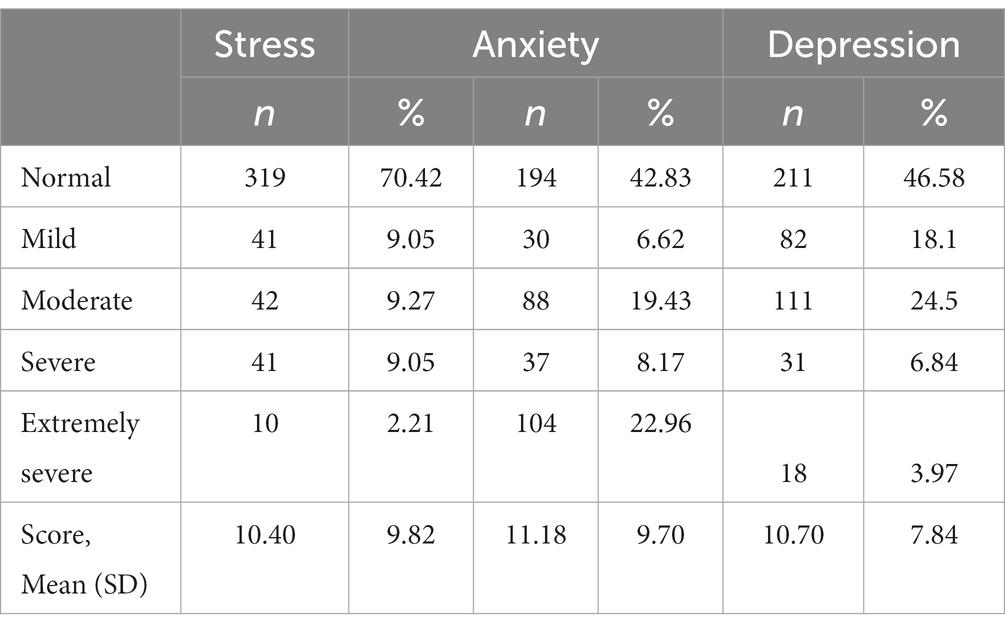
Table 4. Descriptive statistics of Stress, Anxiety, and Depression among Qassim University students (N = 453).
3.5 Sociodemographic variables associated with Depression, Anxiety, and Stress
The mean scores for Depression, Anxiety, and Stress symptoms among women were 13.56, 13.90, and 12.52, respectively. Men had mean values for Depression, Anxiety, and Stress of 9.66, 9.63, and 8.61, respectively. Male students had higher mean values than female students on Stress (p < 0.001), Anxiety (p < 0.001), and Depression (p < 0.001), respectively (Table 5).
The study showed that the mean scores for Depression, Anxiety, and Stress levels for students aged 18–24 were 10.49, 11.24, and 10.96, respectively. The mean values for Stress, Anxiety, and Depression in students over 24 were 9.61, 10.65, and 8.39, respectively. Students aged more than 24 had higher mean values than those aged 18–24 years on Stress (p = 0.564), Anxiety (p = 0.698), and Depression (p = 0.035) (Table 5).
For medical students, the mean scores for Depression, Anxiety, and Stress were 10.56, 11.52, and 10.52, respectively. For non-medical students, the mean scores for Depression, Anxiety, and Stress were 10.76, 11.02, and 10.35, respectively. Stress scores for non-medical students were higher on average (p = 0.861). At the same time, the mean Anxiety and Depression scores were slightly higher among students from the medical colleges (p = 0.612 and p = 0.806, respectively) (Table 5).
The mean values of Depression, Anxiety, and Stress for first-year students were 9.68, 10.24, and 9.11, respectively; 11.62, 11.81, and 10.82 for second-year students, respectively; 11.21, 12.53, and 12.08 for third-year students, respectively; 11.89, 10.83, and 10.33, respectively, for the fourth-year students; and 8.87, 10.32, and 9.47, respectively, for fifth-year students (Table 5).
The multivariable analysis shows that gender (p ≤ 0.001) was associated with Stress, Anxiety, and Depression. Compared to first-year students, students studying in the third year experienced higher levels of stress (p = 0.005), anxiety (p = 0.027), and depression (p = 0.053). Similarly, compared to first-year students, students studying in the fourth year also experienced higher levels of depression (p = 0.006) (Table 6).
4 Discussion
This study aimed to evaluate the prevalence and sociodemographic determinants of Depression, Anxiety, and Stress during the COVID-19 pandemic among students at Qassim University, Saudi Arabia. Our study found that at least 30% of the students experienced higher levels of Stress, 47% of students experienced higher levels of Anxiety, and 43% of students experienced higher levels of Depression.
During the pandemic, Qassim University ceased all operations, there were also several nationwide lockdown measures at the community level. In addition, students were afraid of being infected with COVID-19. Given the situation, it is natural that the students suffered from psychological distress. In our study, the mean levels of Depression, Anxiety, and Stress were 10.70, 11.18, and 10.40, respectively. These results were consistent with a study conducted in Saudi Arabia on the general population during the COVID-19 pandemic (43). A systematic review also found similar levels of abnormal Depression, Anxiety, and Stress among the general population (44). Furthermore, our findings are similar to a study conducted among nursing students from Hong Kong during the COVID-19 outbreak (45).
Our study found that, among Qassim University students, at least 30% of the students experienced higher levels of stress, 47% of students experienced higher levels of anxiety, and 43% of students experienced higher levels of depression. A study conducted among university students across Saudi Arabia during the pandemic (2 April 2020–5 April 2020) that used the DASS-21 tool also found similar levels of Depression (56%), Anxiety (40%), and Stress (41%). Another study conducted among university students in Riyadh found that 75% of the university students suffered different levels of depression during the pandemic (46). It is possible that the pressure students felt to complete their coursework successfully, earn top marks, and perform at their best during their education are contributing factors to these elevated levels of Depression, Anxiety, and Stress (47). Our study was conducted toward the end of the pandemic when the students started coming back to the university. Nonetheless, the prevalence of psychological symptoms suggests that students need professional support even after the pandemic is over, and the impact of the pandemic is present even after it is almost over. Due to a lack of data from the rest of Saudi Arabia, generalizations cannot be made about these findings. However, the data are comparable to previous studies conducted in Saudi Arabia. This suggests that university students in Saudi Arabia experienced abnormal levels of Depression, Anxiety, and Stress during and after the COVID-19 pandemic.
The Stress associated with attending university may be brought on by several things, including the need to memorize vast amounts of material, academic rivalry among students there, grade point averages, and a fear of failing (48). We evaluated the mental health of students in Saudi Arabia using the pre-validated DASS-21. It, therefore, had the additional benefit of making it simple to compare the findings with those of research reporting on variables related to mental health. This was especially true for most studies involving students because those studies used the DASS-21. The findings of the study were comparable to the research on Saudi Arabian dentistry students.
In our study, female students experienced more Depression, Anxiety, and Stress than male students. A systematic review, found that female medical students in Saudi Arabia also had a higher risk of depression than male students (26). In a study conducted among dental students in Saudi Arabia, depressive symptoms were higher in female students than in their male counterparts (47). Our findings were consistent with the research on the mental health of students in various other nations (49–53). Contrary to the results from our study, a study conducted among Jordanian university students found that male participants were influenced more than female participants (54). Clinical elements, including technical skills, were the most distressing for male students (54). However, the sociocultural context of Saudi Arabia may differ. This finding could be explained by the fact that, compared to men, women tend to have greater hyperactivity and cognitive disorders (55). Moreover, women experience more mental health problems due to the responsibilities they acquire from an early age, exposure to sexual abuse, and domestic violence (56).
In this study, the levels of Depression, Anxiety, and Stress did not differ according to the age of the student or field of study (Medical vs. Non-medical). A previous study conducted among Saudi Arabian university students did not find age and field of study to be associated with mental health symptoms (57).
According to the findings, first-year students experienced lower levels of Depression, Anxiety, and Stress than third-year senior students. A study conducted in Malaysia also found higher psychological symptoms among senior students (58). This could be due to the increasing workload in senior year and the fact that senior students are closer to graduation and must consider the future. A study conducted among orthodontic students before COVID-19 found no difference in Depression, Anxiety, and Stress levels among students from different academic years (59). This could be due to differences in the study context and sampling variations. It is also possible that COVID-19 may have contributed to higher stress among senior students in the middle of their university studies. According to a study by Naidu et al. on the causes of stress and psychological problems in college students, the general stress level increased as the students progressed (60). However, in our study, the experience of higher levels of stress was not consistent across all academic years. Further research is needed to understand this issue better.
This study has some important strengths. We used virtual data collection suitable for a pandemic, given that Saudi students are used to online activities. The data were collected immediately after the pandemic was almost over and when students started attending in-person classes. Therefore, our study findings represent the mental health status of students as they return to classes after the pandemic. We used the standard tool DASS-21, which allowed us to compare our findings with other studies. In addition, we have established the validity and reliability of DASS-21 for this study population. Finally, we have collected data from students of all disciplines, so the data are representative of all university students. Our study will contribute to the existing body of knowledge about the prevalence of stress, anxiety, and depression after a pandemic is over. Although we cannot conclude the impact of a pandemic from this study, it can highlight the need for public health measures to be taken post-pandemic. Moreover, our findings can shed light on the characteristics of students more prone to experiencing psychological symptoms due to a pandemic.
The study had some limitations. The non-probability nature of the sampling of the students may limit our findings’ generalizability. Given the fact that we had to reach the students virtually, it is possible that our sample is not representative of all types of students. Moreover, we only collected data from Qassim University students, so the findings can only be generalized to universities that are similar to Qassim University in terms of student profile. Nonetheless, our results are comparable to other studies conducted in Saudi Arabia among University students. We only collected data at a one-time point; thus, we cannot understand how psychological symptoms changed throughout the pandemic.
5 Conclusion
Students in the current study reported experiencing higher levels of Depression, Anxiety, and Stress immediately after the COVID-19 pandemic when they returned to classes. Depression, Anxiety, and Stress levels were associated with gender. These findings suggest that, even after the pandemic is almost over, students may experience psychological symptoms as they return to study. The findings of the current study can help universities gauge and treat current Stress, sadness, and Anxiety levels, as well as direct program development and mental health program implementation. Future research in this field should focus on developing and evaluating effective interventions to prevent and manage psychological symptoms among university students experiencing pandemics such as COVID-19.
Data availability statement
The raw data supporting the conclusions of this article will be made available by the authors, without undue reservation.
Ethics statement
The studies involving humans were approved by Committee of Research Ethics at Qassim University. The studies were conducted in accordance with the local legislation and institutional requirements. Written informed consent for participation was not required from the participants or the participants’ legal guardians/next of kin because virtual informed consent was obtained when the participants completed the online survey.
Author contributions
IA: Conceptualization, Formal analysis, Funding acquisition, Investigation, Methodology, Project administration, Resources, Supervision, Validation, Writing – original draft, Writing – review & editing. AA: Conceptualization, Data curation, Formal analysis, Investigation, Methodology, Project administration, Software, Validation, Visualization, Writing – review & editing. MAlh: Conceptualization, Data curation, Formal analysis, Investigation, Methodology, Project administration, Software, Validation, Visualization, Writing – review & editing. MAlf: Conceptualization, Data curation, Formal analysis, Investigation, Methodology, Project administration, Software, Validation, Visualization, Writing – original draft, Writing – review & editing.
Funding
The author(s) declare financial support was received for the research, authorship, and/or publication of this article. The authors gratefully acknowledge Qassim University, represented by the Deanship of “Scientific Research, on the financial support for this research under the number (PHSC-2022-1-1-J28357) during the academic year 1444 AH/2022AD.”
Conflict of interest
The authors declare that the research was conducted in the absence of any commercial or financial relationships that could be construed as a potential conflict of interest.
Publisher’s note
All claims expressed in this article are solely those of the authors and do not necessarily represent those of their affiliated organizations, or those of the publisher, the editors and the reviewers. Any product that may be evaluated in this article, or claim that may be made by its manufacturer, is not guaranteed or endorsed by the publisher.
References
1. WHO . COVID-19 public health emergency of international concern (PHEIC) global research and innovation forum. Switzerland: World Health Organization Geneva (2020).
2. Algaissi, AA, Alharbi, NK, Hassanain, M, and Hashem, AM. Preparedness and response to COVID-19 in Saudi Arabia: building on MERS experience. J Infect Public Health. (2020) 13:834–8. doi: 10.1016/j.jiph.2020.04.016
3. Nurunnabi, M . The preventive strategies of COVID-19 pandemic in Saudi Arabia. J Microbiol Immunol Infect. (2021) 54:127–8. doi: 10.1016/j.jmii.2020.07.023
4. Alshammari, TM, Altebainawi, AF, and Alenzi, KA. Importance of early precautionary actions in avoiding the spread of COVID-19: Saudi Arabia as an example. Saudi Pharm J. (2020) 28:898–902. doi: 10.1016/j.jsps.2020.05.005
5. Salari, N, Hosseinian-Far, A, Jalali, R, Vaisi-Raygani, A, Rasoulpoor, S, Mohammadi, M, et al. Prevalence of stress, anxiety, depression among the general population during the COVID-19 pandemic: a systematic review and Meta-analysis. Glob Health. (2020) 16:1–11. doi: 10.1186/s12992-020-00589-w
6. Lau, JTF, Yang, X, Pang, E, Tsui, HY, Wong, E, and Wing, YK. Sars-related perceptions in Hong Kong. Emerg Infect Dis J. (2005) 11:417–24. doi: 10.3201/eid1103.040675
7. Rubin, GJ, Potts, HW, and Michie, S. The impact of communications about swine flu (influenza a H1n1v) on public responses to the outbreak: results from 36 National Telephone Surveys in the UK. Health Technol Assess. (2010) 14:183–266. doi: 10.3310/hta14340-03
8. Brooks, SK, Webster, RK, Smith, LE, Woodland, L, Wessely, S, Greenberg, N, et al. The psychological impact of quarantine and how to reduce it: rapid review of the evidence. Lancet. (2020) 395:912–20. doi: 10.1016/S0140-6736(20)30460-8
9. Al Najjar, N, Attar, L, Farahat, F, and Al, TA. Psychobehavioural responses to the 2014 Middle East respiratory syndrome-novel Corona virus [Mers Cov] among adults in two shopping malls in Jeddah, Western Saudi Arabia. EMHJ Eastern Mediterranean Health J. (2016) 22:817–23. doi: 10.26719/2016.22.11.817
10. Hassounah, M, Raheel, H, and Alhefzi, M. Digital response during the COVID-19 pandemic in Saudi Arabia. J Med Internet Res. (2020) 22:e19338. doi: 10.2196/19338
11. Abed, MG, Abdulbaqi, RF, and Shackelford, TK. Saudi Arabian Students’ beliefs about and barriers to online education during the COVID-19 pandemic. Children. (2022) 9:1170. doi: 10.3390/children9081170
12. AlAteeq, DA, Aljhani, S, and AlEesa, D. Perceived stress among students in virtual classrooms during the COVID-19 outbreak in KSA. J Taibah Univ Med Sci. (2020) 15:398–403. doi: 10.1016/j.jtumed.2020.07.004
13. Basheti, IA, Mhaidat, QN, and Mhaidat, HN. Prevalence of anxiety and depression during COVID-19 pandemic among healthcare students in Jordan and its effect on their learning process: a National Survey. PLoS One. (2021) 16:e0249716. doi: 10.1371/journal.pone.0249716
14. Islam, MA, Barna, SD, Raihan, H, Khan, MNA, and Hossain, MT. Depression and anxiety among university students during the COVID-19 pandemic in Bangladesh: a web-based cross-sectional survey. PLoS One. (2020) 15:e0238162. doi: 10.1371/journal.pone.0238162
15. Mir, IA, Ng, SK, Mohd Jamali, MNZ, Jabbar, MA, and Humayra, S. Determinants and predictors of mental health during and after COVID-19 lockdown among university students in Malaysia. PLoS One. (2023) 18:e0280562. doi: 10.1371/journal.pone.0280562
16. Simegn, W, Dagnew, B, Yeshaw, Y, Yitayih, S, Woldegerima, B, and Dagne, H. Depression, anxiety, stress and their associated factors among Ethiopian university students during an early stage of COVID-19 pandemic: an online-based cross-sectional survey. PLoS One. (2021) 16:e0251670. doi: 10.1371/journal.pone.0251670
17. Lei, L, Huang, X, Zhang, S, Yang, J, Yang, L, and Xu, M. Comparison of prevalence and associated factors of anxiety and depression among people affected by versus people unaffected by quarantine during the Covid-19 epidemic in southwestern China. Med Sci Monitor. (2020) 26:e924609. doi: 10.12659/MSM.924609
18. Cao, W, Fang, Z, Hou, G, Han, M, Xu, X, Dong, J, et al. The psychological impact of the COVID-19 epidemic on college students in China. Psychiatry Res. (2020) 287:112934. doi: 10.1016/j.psychres.2020.112934
19. Zhou, S-J, Zhang, L-G, Wang, L-L, Guo, Z-C, Wang, J-Q, Chen, J-C, et al. Prevalence and socio-demographic correlates of psychological health problems in Chinese adolescents during the outbreak of COVID-19. Eur Child Adolesc Psychiatry. (2020) 29:749–58. doi: 10.1007/s00787-020-01541-4
20. Meo, SA, Abukhalaf, AA, Alomar, AA, Sattar, K, and Klonoff, DC. COVID-19 pandemic: impact of quarantine on medical students’ mental wellbeing and learning behaviors. Pak J Med Sci. (2020) 36:S43–8. doi: 10.12669/pjms.36.COVID19-S4.2809
21. Auerbach, RP, Mortier, P, Bruffaerts, R, Alonso, J, Benjet, C, Cuijpers, P, et al. Who world mental health surveys international college student project: prevalence and distribution of mental disorders. J Abnorm Psychol. (2018) 127:623–38. doi: 10.1037/abn0000362
22. Pfefferbaum, B, and North, CS. Mental health and the COVID-19 pandemic. N Engl J Med. (2020) 383:510–2. doi: 10.1056/NEJMp2008017
23. Al Omari, O, Al Sabei, S, Al Rawajfah, O, Abu Sharour, L, Aljohani, K, Alomari, K, et al. Prevalence and predictors of depression, anxiety, and stress among youth at the time of Covid-19: an online cross-sectional multicountry study. Depress Res Treat. (2020) 2020:1–9. doi: 10.1155/2020/8887727
24. Ali, M, Uddin, Z, Amran Hossain, KM, and Uddin, TR. Depression, anxiety, stress, and suicidal behavior among Bangladeshi undergraduate rehabilitation students: an observational study amidst the COVID-19 pandemic. Health Sci Rep. (2022) 5:e549. doi: 10.1002/hsr2.549
25. Husky, MM, Kovess-Masfety, V, and Swendsen, JD. Stress and anxiety among university students in France during COVID-19 mandatory confinement. Compr Psychiatry. (2020) 102:152191. doi: 10.1016/j.comppsych.2020.152191
26. AlJaber, MI . The prevalence and associated factors of depression among medical students of Saudi Arabia: a systematic review. J Fam Med Primary Care. (2020) 9:2608–14. doi: 10.4103/jfmpc.jfmpc_255_20
27. Aboalshamat, K, Hou, X-Y, and Strodl, E. Psychological well-being status among medical and dental students in Makkah, Saudi Arabia: a cross-sectional study. Med Teach. (2015) 37:S75–81. doi: 10.3109/0142159X.2015.1006612
28. Hakami, Z, Khanagar, SB, Vishwanathaiah, S, Hakami, A, Bokhari, AM, Jabali, AH, et al. Psychological impact of the coronavirus disease 2019 (COVID-19) pandemic on dental students: a Nationwide study. J Dent Educ. (2021) 85:494–503. doi: 10.1002/jdd.12470
29. Mirza, AA, Milaat, WA, Ramadan, IK, Baig, M, Elmorsy, SA, Beyari, GM, et al. Depression, anxiety and stress among medical and non-medical students in Saudi Arabia: an epidemiological comparative cross-sectional study. Neurosci J. (2021) 26:141–51. doi: 10.17712/nsj.2021.2.20200127
30. Abdul, NS, Alarbash, SA, Albati, ZH, Alkhelaiwi, NK, Alkhalifa, WQ, and Shenoy, M. Impact of COVID-19 on education, psychological wellness and life style of dental students in Saudi Arabia. Bioinformation. (2022) 18:588–95. doi: 10.6026/97320630018588
31. Albikawi, ZF . Predictors of anxiety, depression, and stress among female university nursing students during the COVID-19 pandemic: a cross-sectional study in Saudi Arabia. J Pers Med. (2022) 12:1887. doi: 10.3390/jpm12111887
32. Alharbi, M, Pasha, SA, and Jehan, M. Investigating the relationship between COVID-19 and depression on faculty and students of Qassim University. Open Macedonian J Med Sci. (2022) 10:1714–8. doi: 10.3889/oamjms.2022.10397
33. Ewid, M, Amal, Y, Billah, SMB, Kalou, Y, Zitoun, OA, Alnaser, AR, et al. Impact of the COVID-19 pandemic on the psychological status of undergraduate medical students in Saudi Arabia: a cross-sectional double-scale study. Medicine. (2023) 102:e33487. doi: 10.1097/MD.0000000000033487
34. Khanagar, SB, and Alfadley, A. Psychological impact of the COVID-19 pandemic on dental interns in Riyadh, Saudi Arabia: a cross-sectional survey. Int J Clin Pediatr Dent. (2020) 13:508–12. doi: 10.5005/jp-journals-10005-1773
35. Sultan, S, Abu Bashar, MD, Tabassum, A, Iqbal, MS, Nomani, I, Almasoudi, NM, et al. Prevalence of depression, anxiety, stress and its relationship with knowledge about COVID-19 in medical and laboratory medicine students of umm-Al-Qura University: a cross-sectional survey. Egypt J Neurol Psychiatr Neurosurg. (2022) 58:160. doi: 10.1186/s41983-022-00590-7
36. Alanazi, M . Psychological status of college students during COVID-19 pandemic: a cross-sectional study in Saudi Arabia. Adv Med Educ Pract. (2022) 13:1443–51. doi: 10.2147/AMEP.S381916
37. AlHadi, AN, and Alhuwaydi, AM. The mental health impact of pandemic COVID-19 crisis on university students in Saudi Arabia and associated factors. J Am Coll Heal. (2023) 71:1854–62. doi: 10.1080/07448481.2021.1947839
38. Alyoubi, A, Halstead, EJ, Zambelli, Z, and Dimitriou, D. The impact of the COVID-19 pandemic on students’ mental health and sleep in Saudi Arabia. Int J Environ Res Public Health. (2021) 18:9344. doi: 10.3390/ijerph18179344
39. Mohammed, Z, Arafa, A, Atlam, ES, El-Qerafi, N, El-Shazly, M, Al-Hazazi, O, et al. Psychological problems among the university students in Saudi Arabia during the COVID-19 pandemic. Int J Clin Pract. (2021) 75:e14853. doi: 10.1111/ijcp.14853
40. Ali, AM, Ahmed, A, Sharaf, A, Kawakami, N, Abdeldayem, SM, and Green, J. The Arabic version of the depression anxiety stress scale21: cumulative scaling and discriminantvalidation testing. Asian J Psychiatr. (2017) 30:5658. doi: 10.1016/j.ajp.2017.07.018
41. Hair, J, Hollingsworth, CL, Randolph, AB, and Chong, AYL. An updated and expanded assessment of Pls-Sem in information systems research. Ind Manag Data Syst. (2017) 117:442–58. doi: 10.1108/IMDS-04-2016-0130
42. Henseler, J, Ringle, CM, and Sarstedt, M. A new criterion for assessing discriminant validity in variance-based structural equation modeling. J Acad Mark Sci. (2015) 43:115–35. doi: 10.1007/s11747-014-0403-8
43. Alkhamees, AA, Alrashed, SA, Alzunaydi, AA, Almohimeed, AS, and Aljohani, MS. The psychological impact of COVID-19 pandemic on the general population of Saudi Arabia. Compr Psychiatry. (2020) 102:152192. doi: 10.1016/j.comppsych.2020.152192
44. Xiong, J, Lipsitz, O, Nasri, F, Lui, LMW, Gill, H, Phan, L, et al. Impact of COVID-19 pandemic on mental health in the general population: a systematic review. J Affect Disord. (2020) 277:55–64. doi: 10.1016/j.jad.2020.08.001
45. Hung, MSY, Ng, WWM, and Choi, EKY. The impacts of the COVID-19 pandemic on Hong Kong nursing students’ mental health and quality of life. Int J Environ Res Public Health. (2022) 19:15117. doi: 10.3390/ijerph192215117
46. Azmi, FM, Khan, HN, Azmi, AM, Yaswi, A, and Jakovljevic, M. Prevalence of COVID-19 pandemic, self-esteem and its effect on depression among university students in Saudi Arabia. Front Public Health. (2022) 10:836688. doi: 10.3389/fpubh.2022.836688
47. Basudan, S, Binanzan, N, and Alhassan, A. Depression, anxiety and stress in dental students. Int J Med Educ. (2017) 8:179–86. doi: 10.5116/ijme.5910.b961
48. Dyrbye, LN, Thomas, MR, and Shanafelt, TD. Systematic review of depression, anxiety, and other indicators of psychological distress among us and Canadian medical students. Acad Med. (2006) 81:354–73. doi: 10.1097/00001888-200604000-00009
49. Pau, AK, and Croucher, R. Emotional intelligence and perceived stress in dental undergraduates. J Dent Educ. (2003) 67:1023–8. doi: 10.1002/j.0022-0337.2003.67.9.tb03685.x
50. Radeef, AS, and Faisal, GG. Stressors and their association with symptoms of depression, anxiety and stress in dental students. Makara J Health Res. (2018) 22:1. doi: 10.7454/msk.v22i2.9064
51. Moore, R, Madsen, LV, and Trans, M. Stress sensitivity and signs of anxiety or depression among first year clinical dental and medical students. Open J Med Psychol. (2019) 9:7–20. doi: 10.4236/ojmp.2020.91002
52. Sravani, A, Doshi, D, Kulkarni, S, Reddy, P, and Reddy, S. Depression, anxiety, and stress among undergraduate dental students in Hyderabad City, Telangana, India: a cross-sectional study. J Indian Assoc Public Health Dent. (2018) 16:26. doi: 10.4103/jiaphd.jiaphd_10_17
53. Naz, N, Iqbal, S, and Mahmood, A. Stress, anxiety and depression among the dental students of University College of Medicine and Dentistry Lahore; Pakistan. Pak J Med Health Sci. (2017) 11:1277–81.
54. Abu-Ghazaleh, SB, Rajab, LD, and Sonbol, HN. Psychological stress among dental students at the University of Jordan. J Dent Educ. (2011) 75:1107–14. doi: 10.1002/j.0022-0337.2011.75.8.tb05156.x
55. Liu, N, Zhang, F, Wei, C, Jia, Y, Shang, Z, Sun, L, et al. Prevalence and predictors of PTSS during COVID-19 outbreak in China hardest-hit areas: gender differences matter. Psychiatry Res. (2020) 287:112921. doi: 10.1016/j.psychres.2020.112921
56. Aveiro-Róbalo, TR, Garlisi-Torales, LD, Chumán-Sánchez, M, Pereira-Victorio, CJ, Huaman-Garcia, M, Failoc-Rojas, VE, et al. Prevalence and associated factors of depression, anxiety, and stress in university students in Paraguay during the COVID-19 pandemic. Int J Environ Res Public Health. (2022) 19:12930. doi: 10.3390/ijerph191912930
57. Alkhamees, AA, and Aljohani, MS. The psychological impact of Covid-19 pandemic on the students of Saudi Arabia. Open Public Health J. (2021) 14:12–23. doi: 10.2174/1874944502114010012
58. Shamsuddin, K, Fadzil, F, Ismail, WSW, Shah, SA, Omar, K, Muhammad, NA, et al. Correlates of depression, anxiety and stress among Malaysian university students. Asian J Psychiatr. (2013) 6:318–23. doi: 10.1016/j.ajp.2013.01.014
59. Al-Shayea, EI . Perceived depression anxiety and stress among Saudi postgraduate orthodontic students: a multi-institutional survey. Pak Oral Dental J. (2014) 34
Keywords: COVID-19 pandemic, mental health, anxiety, depression, stress, students, Saudi Arabia
Citation: Alasqah I, Alhamdan A, Alhouri M and Alfehaid M (2024) Sociodemographic determinants of depression, anxiety, and stress immediately after the COVID-19 pandemic: a cross-sectional study among university students in Saudi Arabia. Front. Public Health. 11:1271536. doi: 10.3389/fpubh.2023.1271536
Edited by:
Susan Andersen, University of Southern Denmark, DenmarkReviewed by:
Jigyansa Ipsita Pattnaik, Kalinga Institute of Medical Sciences (KIMS), IndiaLuis Manuel Mota de Sousa, Universidade Atlântica, Portugal
Muhammad Aqeel, Foundation University Rawalpindi, Pakistan
Copyright © 2024 Alasqah, Alhamdan, Alhouri and Alfehaid. This is an open-access article distributed under the terms of the Creative Commons Attribution License (CC BY). The use, distribution or reproduction in other forums is permitted, provided the original author(s) and the copyright owner(s) are credited and that the original publication in this journal is cited, in accordance with accepted academic practice. No use, distribution or reproduction is permitted which does not comply with these terms.
*Correspondence: Ibrahim Alasqah, i.alasqah@qu.edu.sa
 Ibrahim Alasqah
Ibrahim Alasqah Abdullah Alhamdan
Abdullah Alhamdan Mohammad Alhouri
Mohammad Alhouri Mohammed Alfehaid
Mohammed Alfehaid